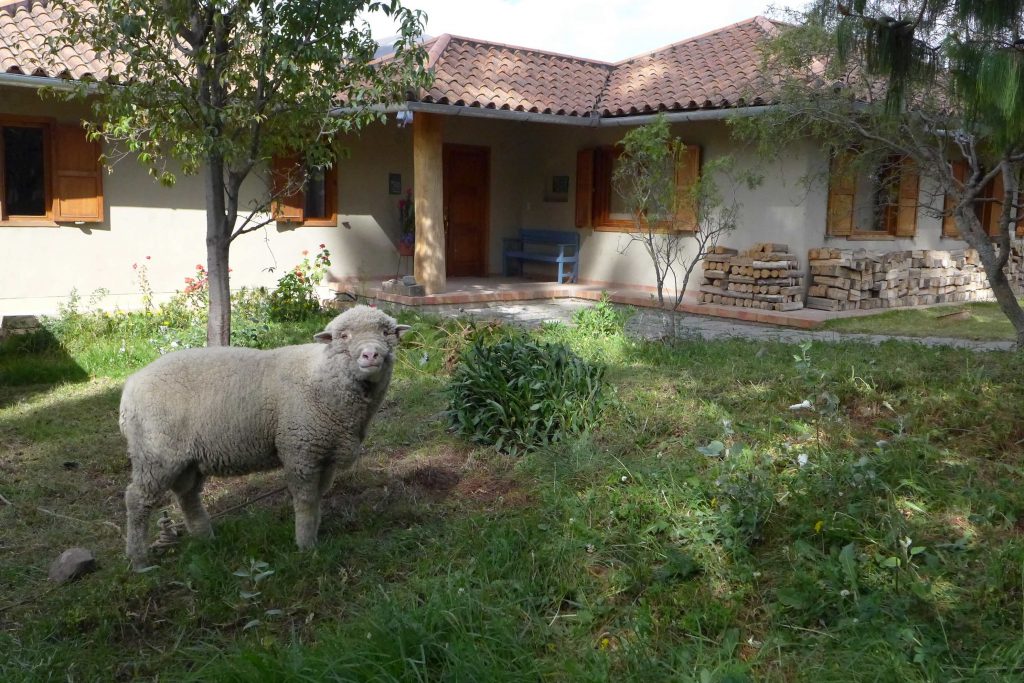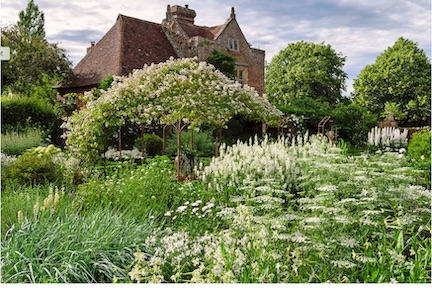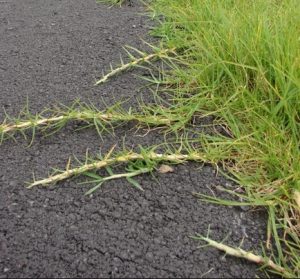Dear Friends – Sissinghurst Gardens in England, made famous (for me) by Virginia Woolf’s love affair with its owner and author, Vita Sackville-West, has nothing in common with my Sisyphus Garden in Cañar. But I like the sound of the two names together (and the coincidence that Sackville-West wrote a novella called Seducers in Ecuador). And another coincidence I just discovered: today, January 25, is Virginia Woolf’s birthday. So I thought I’d start with that and see where it takes us….
 I’m calling my Cañar garden the Sisyphus Garden because no matter what I do one year to the next to improve it, I come back to find it exactly as it was before – new flowers gone, same weeds back in force, kitchen garden eaten by the neighbor’s chickens, trees trimmed further up by the bulls brought in to plow the back field, scrubby grass front and back full of sheep droppings, and the aggressive vinca major (periwinkle) and bushy fuchsia voraciously covering the side yard, even though I cut them back severely before we left last June.
I’m calling my Cañar garden the Sisyphus Garden because no matter what I do one year to the next to improve it, I come back to find it exactly as it was before – new flowers gone, same weeds back in force, kitchen garden eaten by the neighbor’s chickens, trees trimmed further up by the bulls brought in to plow the back field, scrubby grass front and back full of sheep droppings, and the aggressive vinca major (periwinkle) and bushy fuchsia voraciously covering the side yard, even though I cut them back severely before we left last June. And there’s the hedge of quinoa (a native bush, not the grain) that has grown to over 15 feet and blocked our view to the west.
And there’s the hedge of quinoa (a native bush, not the grain) that has grown to over 15 feet and blocked our view to the west.
When it comes to my Cañar garden, I start over every year, just like Sisyphus endlessly pushing that stone up the hill. (Forgive my co-opting a suffragist image; couldn’t resisit.) 
The fact is, we are living on a working farm operated by our compadres Jose Maria and Narcisa. It is their sheep that trim and fertilize the lawn while we’re gone, their bulls that eat the lower branches of the trees, their irrigating the back field that floods the front yard. But they have contributed so tremendously to our experience living in Cañar, and as compadres we are considered extended family, with responsibilities that go both ways. 

As I write, I hear the pump, drawing from the irrigation canal that runs in front of our property. Yards and yards of black pipe snake around the house to irrigate the potato field behind. Jose Maria has access to the canal only today – it has been released from above – and there seems to be no control. Water gushes out of the pipes and into sprinkler heads in the field, soaking the back lawn, the kitchen garden, the back of the house, the neighbor’s clothes hung on the fence. In front, water overflows the canal and runs down the hill, creating rivulets in the dirt road that will become ruts, and creeps along the pathway up to our house and threatens to dampen our adobe walls. Jose María runs back and forth from the pump in front to the field in back; It appears to us that he is flooding the field. Yesterday, the canal was blocked, and we regularly saw neighbors in the yard, looking down into the canal and poking it with a long stick, trying to unblock it. For farmers, water is life and livelihood – and in this part of the world as hotly political as property lines.
Which is not to say that I don’t love things as they are in my Sisyphean garden. First of all, since I have no talent as a gardener – unable to plan or imagine or create a white garden, as Vita Sackville-West did at Sissinghurst – there’s little disappointment in coming back to find I have to start over again.
I never tire of pulling weeds, trimming back the crazy climbing roses, replanting things lost, digging out the crocosmia that is all over the yard because it gets distributed through the compost, cutting back the passiflora vine that threatens to take down the fence, tracking down and pulling up the aggressive kikuyu grass that grows over and under everything and is one of the most noxious weeds that somehow made it to Cañar from its native East Africa. But my pleasure comes from what I see when I look out the windows – flowers I’ve forgotten that bloom year after year; something I’ve stuck in the ground that makes an incredible display of tiny yellow blooms (photo #1), the aggressive fuchsia bush that fills our bedroom window, the white daises along the front that insist on taking over.
And for those who want to see the hated “creeping” kikuyu” up close, here it is. Most often it goes underground, strangling the roots of good plants, or displacing flagstones, before springing up as tall grass. I’ve spent many happy hours chasing it down; farmers throw it in the road to fill ruts. But in fact our lush lawn is mostly made of it, cut short. 
Back to Sisyphus: Camus imagined him smiling while pushing the rock and embracing his situation without thinking of the past or the future. “He refused to surrender to gravity…he is remembered for his labor towards his purpose” Well, I’m not sure I’ve refused to surrender to gravity (I take a look in the mirror), but I certainly feel I have a purpose here in my Sisyphean Cañar garden.
And to finish with Virginia Woolf, from her diary, May 31, 1920: “The first pure joy of the garden . . . weeding all day to finish the beds in a queer sort of enthusiasm which made me say this is happiness. … We were out till nine at night, though the evening was cold. Both stiff and scratched all over today, with chocolate earth in our nails.”
CANAR BOOK CLUB (what you’ve all been waiting for)
The first 2020 meeting of the Cañar Book Club was a rousing success! Our members were obviously anxious to reconvene after six months and share news of books. So I”ll start with our international members’ comments and save my own for the end.
Francie in Portland is reading Like Falling Through a Cloud: A Lyrical Memoir by Eugenia Zukerman, an internationally renowned flutist and writer facing a dreaded diagnosis of
Joanne in Mexico: “I read The Topeka School, by Ben Lerner, on the plane and liked it a lot. Fascinating mix of voices and ways of thinking about language. Definitely recommend. I’m about to start Drive you Plow Over the Bones of the Dead, by Olga Tokarzcuk… and will report.”
Nancy In Portland: How to Catch a Mole. by Marc Hammer. “It’s about moles, but also about a Welsh book editor and gardener growing older, his love and deep connection with nature and determination to stop killing moles. A beautifully reflective book!”
Nancy Also read: Beyond the Beautiful Forevers, by Katherine Boo, 2012 National book award winning nonfiction centered around the lives of slum dwellers near the Mumbai airport. “Deeply empathetic. Harrowing, heartbreaking stories. Reminded me a bit in tone of Matthew Desmond’s book, Evicted. And I also enjoyed Full Catastrophe Living, by Jon Kabat-Zinn— the groundbreaking 1999 introduction to mindfulness meditation.”
And from an indefatigable reader in Austin: “Love your book lists, Judy, and always love how many of your favorites I’ve read and loved. A couple recent reads that I thoroughly enjoyed:” All my Puny Sorrows, by Miriam Towes, Severance by Ling Ma, The Tiger’s Wife by Tea Obrent, Lost Children Archive by Valeria Luiselli, Disoriental by Niger Dyaneli, Overstory by Richard Powers, The Museum of Modern Love, by Heather Rose, The Friend by Sigrid Nunez, Educated by Tara Westover, Meet me at the Museum by Anne Youngson, Heart Berries by Terese Marie Mailhot, My Life of Rest and Relaxation by Ottessa Moshfegh, The Monk of Mokha, by Dave Eggers, Here in Berlin by Cristina Garcia, Asymmetry by Lisa Halliday, The Reluctant Fundamentalist by Mohsin Hamid, The Nakano Thrift Shop by Hiromi Kawakami.
Liv from Oslo wrote, responding to authors I mentioned in our last meeting: “Books: Towles- I have the same experience. Patrick Modiano – mysterious and fascinating. Linn Ullmann- I read it fast – rather nasty to her mother, Liv Ullmann. It seems to be a trend in Norway right now. I got presents: Ruth First and Joe Slovo against Apatheid by Alan Wieder, and Upside Down. A Primer for the Looking Glass World by Eduardo Galeano. To recommend: Trieste, by Dasa Drndic.-One of the strongest novel I have read in many years. East West Street, by Philippe Sands.
Two Oregon readers, Shirley and Pat, both recommended Deep River, by Karl Marlantes. Pat writes: “It’s about the Finns who settled both sides of the Columbia R., starting in the 1800’s logging and fishing. It’s 5-stars, very good.”
From Laura in Upstate New York: “What an ambitious list of books. I continue to recommend Elizabeth Gilbert’s The Signature of All Things. It’s also a great audio book, read by the incomparable Juliet Stevenson.”
From Bruce in Portland: Marc Hamer’s How to Catch a Mole. Brilliant. He’s a Welsh writer and his luminous meditations on nature have strong parallels to Wendell Berry’s writing.
Claire from London: My Sister the Serial Killer by Oyinkan Braithwaite is brilliant. Seemingly almost comic to start with, it’s actually a dark tale revealing much about life for young, educated women living and working in Lagos. Short and bittersweet.
Richard from Oslo: I am reading an amazingly constructed book, The Overstory, by Richard Powers, on a psychic revenge taken by trees, some of whom seem to have memories going back 4 million years, and who suddenly are being helped to save greenery in America by certain drop-out, off-the-bend, Americans who, once leaving civilization can groove with trees. For me it is his best since The Echo Maker and also The Prisoner’s Dilemma.
Sister Char in Santa Fe: This is How it Always Is, Laurie Frankel, “Frankel’s portrayal of even the most openhearted parents’ doubts and fears around a child’s gender identity elevates this novel.” New York Times Bestseller, 2017
And from Arlene in Toronto, late last year, neatly presented as a bulleted list:
- The House of Names, Colm Toibin
- The Testament of Mary, Colm Toibin
- Home Fire by Kamila Shamsie
- The Children of Jocasta by Natalie Haynes
- What My Mother and I Don’t Talk About: Fifteen Writers Break the Silence by Michele Filgate
Whew! And now for those who’ve made it this far, my report:
Since our last meeting I have read A Gentleman in Moscow – charming in the end but such a time sink – it took me 3 tries to get into it; Bad Blood I ordered and read for the second time; an amazing memoir by the English academic feminist, Lorna Sage, growing up in rural England in the 1950s. Won many prizes when it came out in 2000, right before she died at age 58. The Wonder by Emma Donoghue – author of Room – about a “fasting girl” of 19th century Ireland where I learned a tremendous amount about the power of Catholic belief, sin and redemption. Reads a bit like a mystery (nominated for Shirley Jackson Award). I’m now reading The End of Days by Jenny Erpenbeck, the German author I so admired last year with Go, Went, Gone and The Visitation. Jury’s still out on this one – I’ll report in next time.
I’m still struggling to connect with e-books. Those I download from the library I forget or barely start, then after 3 weeks they’re gone. I have bought and partially read Life in The Garden by Penelope Lively, a writer I’ve long admired but I find her essays on gardens a little boring (but she brought me to Virginia Woolf’s love of garden). Oliver Sack’s’ last book of essays, Everything in Its Place: First Loves and Last Tales, came and went. I love him, but I realized many were essays I’d already read. Bottom line: there’s nothing like having a quality-paper book in one’s hands for a long bus ride, or those fleeting minutes before the lights go out at night.
Until next time, dear readers. Keep those book suggestions and comments coming for our February book club meeting.













Jude! Love your account and the drawing of you (as suffragette) with flowery rock
is brilliant! Love the shots of your over-grown yard, the animals, the people.
And so many great book tips from everyone!! I have resolved to give up the screen
for the page right now!! …(well, after this season’s ALONE…which you might like
as it takes place in the great Northwest, your ‘other home’!) –
Thank you for all!! Sending love on the brink of February. love xoxo sherry
Hmmm, thanks Sher – I will check out Alone. Along with books, we need a good TV series. On Netflix I hope? I’ve just given up Amazon Prime.
It’s been very enjoyable for me reading this post of yours. You see, my English still need more practice, but I have happily managed to understand most of it. And some of the books in here have called my attention, they seems to be very interesting, I am putting some of them to my reading list. I will be visiting you and Mike soon.
Hello Pachacutig – Your English is very good! Mike and I look forward to seeing you next time you come to Cañar. Un abrazo, Judy
Just read your wonderful book list. Wonder if you have ever read Down the Garden Path by Beverly Nichols? A jewel for gardners!!
Judy just read your post. Love your book lists wonderful! Wondering if you have ever read Down the Garden Path by Beverley Nichols! A treasure!
Hi Sue – No I haven’t, but it will go on my February Cañar Book Club list of recommendations. Be sure to join in!
Tell me, what else should I have done? Doesn’t everything die at last, and too soon? Tell me, what is it you plan to do. With your one wild and precious life?
The Summer Day, ..Mary Oliver
Jude, thank you for such a wonderfully constructed post. From Vita Sackville-West
to the sheep gazing out from your front yard and the sprinklers on the clothesline.
It was so much fun to imagine your role in controlling that garden!
Love what you did with the rock!
I don’t have a decent book to add to the book club today, but I do have poetry.
I loved poetry all through high school and have just rediscovered it while doing
my collage. Collage loves a theme from a poem.
I especially like all the poetry concerning nature, the climate, and our interaction, (or not) that is being written now. The New Yorker has printed many poems having to do with Climate change.
Here are 2 of my favorites. They are both worth looking up.
The Climate Annelyse Gelman
Nature Bianca Stone
Love, sister Char
Que maravilla! Han pasado ya varios años de nuestra visita y no hemos dejado de seguir las aventuras de tu jardín encantado.
un gran abrazo para ti y Michael
Santiago y Clara